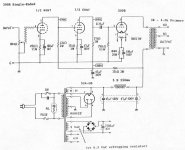I built one of these about 20 years ago and now that I have a pair of Klipsch speakers I want to build another one.
In the filament circuit there is a 100 ohm hum balance pot. But this circuit shows DC 5 volts on the 300b filament. I thought the hum balance pot was only needed for AC filaments.
Basically, I've forgotten.
In the filament circuit there is a 100 ohm hum balance pot. But this circuit shows DC 5 volts on the 300b filament. I thought the hum balance pot was only needed for AC filaments.
Basically, I've forgotten.
Attachments
I thought the hum balance pot was only needed for AC filaments.
It helps to null out the remaining ripple on the rectified and filtered filament voltage.
You'll appreciate it with such high efficiency speakers.
The 2200uF capacitor is a little light for the 1.2A filament current. I'd go with more like 10,000uF.
Full-wave bridge rectifier with capacitor filter and ripple voltage - Electrical Engineering Stack Exchange
Last edited:
1. You will need a higher secondary voltage than 5Volts if you use a regulator IC. 5Vrms gives 7Vpeak going to the schottkey bridge, and with 0.3V per diode (2 diodes at a time) you only get 6.4Vpeak. 6.4V -5V (300B), only gives 1.6V for the regulator to work properly, which most ICs will not do very well.
Or . . . 2. 5V secondary to Schottkey bridge to 10,000uF, to 1.2 Ohm, to 10,000uf would give about 5V and just a few millivolts of ripple. Then 2 series 25 Ohm resistors across the filament with the middle of the 25 Ohm Rs to the bias resistor to ground (bypassed with the cap). A little adjustment of the 1.2 Ohms will let you get the 5V dead on when your line voltage is at its average or usual value. The few millivolts will be quite well balanced out, and any residual at the plate will be divided by the OPT step-down ratio. Worked for me (I went wild and used two 20,000 uF).
Brute force power as in 2. above, does have a slight disadvantage: If you power 1.2A DC, you ought to use a secondary that can do almost 2X, so spec a 2.5A winding for 1.2A DC, you will have a much cooler transformer.
Or . . . 2. 5V secondary to Schottkey bridge to 10,000uF, to 1.2 Ohm, to 10,000uf would give about 5V and just a few millivolts of ripple. Then 2 series 25 Ohm resistors across the filament with the middle of the 25 Ohm Rs to the bias resistor to ground (bypassed with the cap). A little adjustment of the 1.2 Ohms will let you get the 5V dead on when your line voltage is at its average or usual value. The few millivolts will be quite well balanced out, and any residual at the plate will be divided by the OPT step-down ratio. Worked for me (I went wild and used two 20,000 uF).
Brute force power as in 2. above, does have a slight disadvantage: If you power 1.2A DC, you ought to use a secondary that can do almost 2X, so spec a 2.5A winding for 1.2A DC, you will have a much cooler transformer.
Last edited:
Why not follow the lead of a number of us who use Rod Coleman regulators which are specially designed for DHTs and have gone through several years of revisions and improvements. Good value and pretty much state of the art.
Why do you need 3 stages here? There are numerous good designs with 2 stages. If the 3 stages were DHTs like 26, 10Y, 01A, 4P1L than maybe you could make a viable case for that, but a 6SN7 isn't remarkable enough in sound quality to make it worth using in preference to a higher gain single driver stage. Look at tubes like 6e5p and 6e6p for instance, and plenty of others with higher gain.
Why do you need 3 stages here? There are numerous good designs with 2 stages. If the 3 stages were DHTs like 26, 10Y, 01A, 4P1L than maybe you could make a viable case for that, but a 6SN7 isn't remarkable enough in sound quality to make it worth using in preference to a higher gain single driver stage. Look at tubes like 6e5p and 6e6p for instance, and plenty of others with higher gain.
Not right now, but it wouldn't be difficult to work out some ballpark values. I'm sure you'd have some ideas for that. I do intend to build this combination at some point. I would have thought others have tried it as well, so there should be some circuits floating about on the Net.
- Status
- This old topic is closed. If you want to reopen this topic, contact a moderator using the "Report Post" button.
- Home
- Amplifiers
- Tubes / Valves
- Help me out with this 300b schematic
